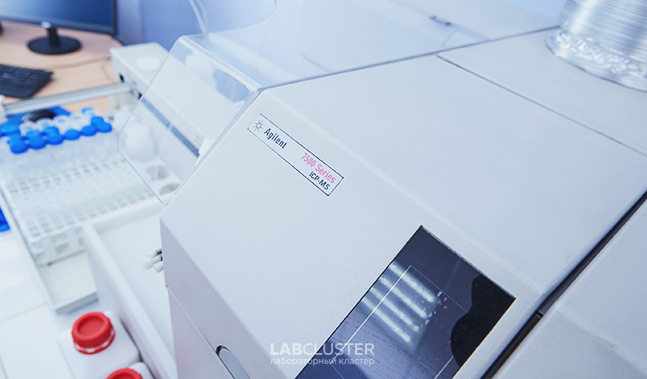ICP-MS favorably differs from atomic absorption spectroscopy with electrothermal and flame atomization by high reproducibility, low detection limits (up to 10-12 g/dm3) and a wide range of detectable elements (68 elements of the periodic system).
Basics of inductively coupled plasma mass spectroscopy
In the spray chamber, the liquid sample is mixed with a plasma-forming gas (argon) to form an aerosol, which then enters the plasma via a pneumatic spray gun. Argon plasma is supported by an inductor, which is supplied with voltage from a high-frequency generator. When an aerosol enters the plasma, its particles are desolvated, and the molecules are destroyed to atoms, which in turn are partially ionized. Further, a part of the plasma with the detected ions contained in it is extracted to the interface, this is the zone where electrons and neutral particles are removed from the plasma due to a gradual decrease of pressure to 10-6 Pa. At the interface exit the plasma consists only of light photons, ions, and neutral atoms. Further, passing through the system of ion optical lenses, positively charged ions enter the quadrupole mass analyzer, which works on the principle of a filter, that is, when the voltage changes on the quadrupole, only certain ions with a specific mass-to-charge ratio can pass through it, reaching the detector.
Preparation of various types of water samples for analysis
Sample preparation of drinking water is carried out by adding concentrated nitric acid (2 cm3) to the volume of the water sample (100 cm3), the resulting solution is mixed and settled for at least 2 hours. For waste waters and natural waters containing visible suspension, sample preparation for analysis is carried out by heating a certain volume of the sample (100 cm3) with the addition of concentrated nitric acid (2 cm3) and hydrogen peroxide (1 cm3), evaporating the sample to ¼ of the volume and bringing the resulting sample volume to 100 cm3 by deionized water. If there is a sediment left in the prepared sample after mineralization, it is disposed of by filtration of the sample.
Specific application of ICP-MS for analysis of samples with high salinity
A special feature of the ICP-MS method is the strong influence of the sample matrix on the measurement of the determined elements. That is, even solutions with concentrations of (0.1-1) g/dm3 can strongly suppress the analytical signal, which in turn affects the quality of the analysis. Predominance of elements with low ionization energy in the sample matrix leads to a decrease in the accuracy of determination of elements with higher ionization energy. This is due to an increase in the volume charge in the ion stream and the loss of some positive ions in the zone between the skimmer and the quadrupole. Due to this method feature, for example, sea water with a high content of easily ionized sodium ions requires preliminary dilution of the sample to obtain a correct reproducible analysis result.
In our laboratory, a quadrupole mass spectrometer with inductively coupled plasma Agilent 7500A is used to measure mass concentrations of metals in samples of drinking, natural and waste water. This device is able to provide highly informative trace analysis of samples containing more than 70 elements of the periodic system.
Price-list for waste water research






